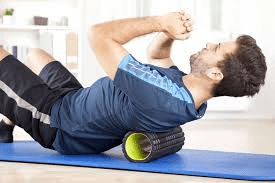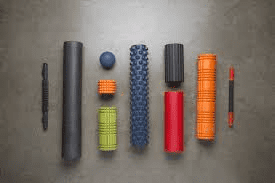You often have felt pain due to muscle stiffness in traps; Low back, hamstrings, glutes and calves. It occurs due to poor sitting posture or sleeping with a soft pillow height. There are other causes of muscle soreness, including sitting for long hours or performing a high-intensity exercise.

What exactly is foam rolling?
The foam roller is used to prevent soreness, knots and enhance joint range of motion in the body through myofascial release. It is a way of self-administered myofascial release.
You must have seen foam roller in the gym or the physical therapist office. Physical therapists also use it to perform isometric exercises. The foam roller SMR is loved by Physical therapists and fitness trainers alike.
Types of foam roller
The foam rollers come in a variety of shapes, sizes and types. The most common foam roller is a Plain roller, it varies in heigh, density and size.
Other foam rollers are;
- Vibrating foam roller
- Hollow core foam roller
- Treaded foam roller
Cumulative injury cycle
Our muscles go through rigorous mechanical stress throughout the day. It builds up eventually over time and causes injuries to the muscle fibers. The micro tear in muscle fibers follows through an inflammation process and results in the development of soft tissue adhesions.
The body recognizes the tears in the muscle, targets them as injury and initiates the repairing process. It is known as the Cumulative Injury Cycle. The cycle goes through inflammation, the muscle goes into spasm, and scar tissue development.
Why should everyone do foam rolling?
In my opinion, I would recommend foam rolling to almost everyone. It has a wide variety of benefits and can be an excellent addition to daily exercise. We all feel muscle soreness, taut bands, tight knots and stiff muscles.
Foam rolling solely treats all of these conditions. Just a few minutes of the day, and you are good to go.
- Increased muscle pliability
- It increases flexibility
- Increases range of motion and joint mobility
- It helps you get into the problem spot rather than stretching the whole muscle
- It enhances performance specifically in athletes
- Accelerate recovery process
- Help you recover better from a strenuous workout
- It is more effective than static and dynamic stretches
- It provides better results in pre-performance and post-performance.
- It helps decrease DOMS
- Decrease soreness
- Reduction in trigger points and muscle knots
- Improve neuromuscular signals
- Induce muscle relaxation
- Improve and correct muscle imbalance

Self-myofascial release techniques mainly focus on neurofascial systems that are oppositely influenced by abnormally poor posture, repetitive trauma and dysfunctional movements.
Our muscles are made up of a bundle of fibres, like a bunch of spaghetti. These fibres contract and relax while performing the muscle action. When a person overworks hard, the muscles get tight, resulting in the development of scar tissue.
The micro-tears in the muscles make them tighter. It occurs in individuals who;
- Perform high-intensity exercise.
- Sedentary individuals who don’t use their muscles that much regularly but have to lift something heavy occasionally.
- Bedridden patients who have synergy patterns developed
- The muscles get tightened up in those patients who were on bed rest for months due to injury.
Benefits of foam rolling SMR
If you palpate your muscles, you’ll feel tight spots in there, followed by normal muscles. There is reduced blood flow and nutrients in those tight knots. When you mobilize them by hand or with a foam roller, it feels incredible because the blood flows in these spots increase, and it washes away all those waste products built up in response to inflammation.
The muscles could be inherently tight due to psychological stress, mechanical stress, wrong body mechanics or poor posture. With foam rollers, it is easy to isolate the trouble areas and treat them effectively.
Warm-up/ Cooldown
The foam rolling technique is used as an essential aspect of the workout. Ideally, foam rolling should be done before dynamic muscle stretching activities. It is Performed on overactive tissues as a part of the cooling process, after a workout session.
Before workout
- As a part of warm-up exercise
- Increases blood flow to the muscles
- Enhances range of motion in joints
- It focuses on the entire limb or region that is going to be involved in exercise
After Workout
- As a part of the cool down process
- Find the sore muscle area.
- Roll the foam roller over it for less than a minute
- It mobilizes the muscles and helps to clear away lactic acid build-up quickly
- This helps reduce the incidence of DOMs.
Increase Range of motion and Joint mobility
The foam roller breaks adhesions in the soft tissue with the help of self-mobilization. It enhances the muscle to lengthen appropriately without any restrictions.
When the muscles around the joints are stiff, the person doesn’t move that limb in fear of pain. When these taut bands and knots are released with the help of self-myofascial release, you can nicely hold, relax and contract muscles and achieve a full range of motion in the joint.
Enhances recovery process
The most common presentation of muscle soreness is DOMs ( delayed onset muscle soreness). It is a phenomenon that develops after 24/48 hours of high-intensity exercise.
During exercise, your body is all warmed up, and you don’t feel changes in your muscles. So you get overboard and exercise more than your body can handle. After a few hours, when your body comes to the natural temperature, you mainly feel soreness and knots in your overworked muscles.
Foam rollers are the best exercise for the body pre-workout and post-workout as their rolling technique releases soreness, tightness and stiffness in joints.

Contraindications
Although foam rollers have been seen in people of all ages, certain contraindications for specific diseases should be kept in mind.
Congestive heart failure
Using foam roller increased workup breathing which can not be compensated by a failing heart.
Renal failure
Due to renal failure, performing any isometrics or self-myofascial release may result in renal shock.
Bleeding disorder
If a person has a bleeding disorder, you’ll see his skin will easily break out, and blood will ooze. Performing self-myofascial release is dangerous as it may result in serious medical emergencies.
Clotting disorder
People suffering from the cardiac disease will have varicose veins or spider veins. There’s a good chance that there will be clots in these veins. Self-myofascial release may break the clot, and it might travel all the up to the brain resulting in stroke or, if confined in the heart, then angina.
Contagious skin conditions
Supposedly a person came to the gym with a contagious skin condition; he used the foam roller and left. Then you use the same foam roller; the secretions released from his skin condition come in contact with yours. Now you are also affected with the same disease. Always clean and sanitize before use, or else it is better to get a foam roller of your own.
Conclusion
Foam rolling has been here for decades, but it has recently gained immense popularity and is an integral part of workout sessions. Whether you are a sedentary individual or gym freak, using it for less than a minute gives exceptional results in pre-workout and post-workout sessions.
It increases the recovery process as, during exercise, muscles go through micro-tears in them. Lactic acid also builds up. Using self-myofascial release with foam roller releases the tight knots and taut bands in muscles.
